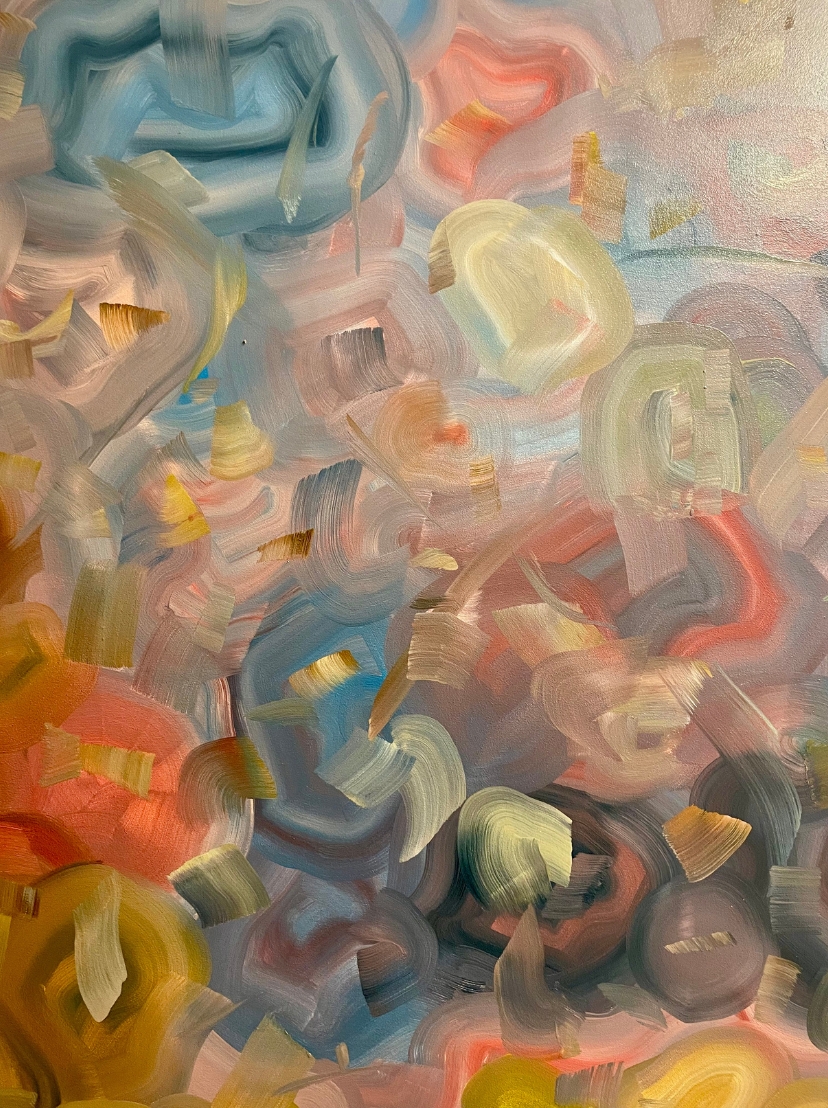Sankhya -' the Flora Flourish '
Akshay Raj Singh Rathore

Akshay Raj Singh Rathore has spent the last decade in Europe but years were interspersed between time spent in China, El Salvador and India. He inhabits Paris with long sojourns in Normandy , Bretagne and Corsica. A constant negotiation of space arises with his migration out of the urban landscape and into the forests , rural fields and the littoral. Here he studies the formation of woods through their barks, counting their age and using pigments from the leaves to colour paper in hues of inks that are derived from the vegetal . Common legumes, salads , fruits and seeds are crushed to make his paints. The act of mark making , shading and staining becomes a painterly process.
Drawing from the Sankhya Philosophy , a rationalist Indic school that does not leave to the Godly but draws from the relationship of ' Purusha ' or 'Consciousness' and Prakriti or ' Nature ' he paints interwoven leitmotifs of colour . These leitmotifs are serpent-like that often mimic fins , the veins of a leaf, are at times circular & abstract but at times also depict a horse . Using a Chinese wash technique their pastel hues are textual in nature and are akin to Chinese script as they are Akshay's conceptual pictograms of nature. According to Sankhya Philosophy nature contains all that is needed to nourish our life on earth and our lives are informed by our observations of nature. Consciousness is in tune with our interactions with nature which in the end decide the quality of our life both materially and spiritually. How does an artist unlearn his art school and imbibe a practice to conceptualise through a mirroring of nature is what Akshay endeavours in his art as an act of catharsis.
Akshay comes from the many who have been displaced from rural hinterlands to urban centres and also those who have become diasporas fleeing their lands as economic refugees of climate change. Across France farmers from the Doaba now tend to vineyards, wheat fields, cheese factories and cows as yields in the Punjab decrease and landholding gets bifurcated amongst families. Each year on his visit to India he makes a pilgrimage to his village in Vidisha. Agriculture no longer sustains his family even though his father raised him through partial proceeds of their farm. Here since the last 15 years he has tried to initiate a rural rejuvenation initiative. It is a slow process of learning and understanding the complexities of socio-cultural but also eco-political norms of people who stand away from the New India. Back home in Normandy a similar isolationary descent occurs where people across Europe are retreating away from the city.
We see a flurry of recent canvases that manifest from the constraints put on him by the use of natural inks , for they are not spontaneous in application but develop a deep stain on the paper. Maneuvering those colours into colour studies he has developed a technique that has actually seeped into his practice when he uses oils. The colour pallette now reminds us of deep reds, pastels and oranges with deep splashes of colour mimicking formal geometries but actually they are landscapes. SH Raza during his first decade in France made canvases of blurred villages in South of France and later began to use bright hues from Indian tantra. Paris Viswanathan had an eye for the deep ochre of mud and sand that reminded him of his home in the Western Ghats of Kerala and the beach behind Cholamandalam. Akshay had a close intimacy with Viswanathan with whom he held deep resonances of mediated observation of the landscape .
Indian artists in France have always sought the landscape Akbar Padamsee was dreaming of lunar metascapes , whilst Ram Kumar explored the vastness and topography through grey, green and sepia. FN Souza, an iconoclast brutally made the vista of a French village into a set of blocks tearing apart its medieval beauty but was presenting it raw. Krishna Reddy acted as if his Guru Nandalal Bose was murmuring in his ear, while observing the formation of leaves to make images . Krishna in his etchings ewas depicting serenity or violence with spontaneous colour achieved by multi-viscosity and multicoloured printmaking. The cause and effect of Purusha -Prakriti has been a conceptual departure for many Indian artists in France . Akshay was consciously looking at nature as a political act and its depiction through deep study that arose from his own interest in agricultural activism.
Watching his toddler son Imaho paint as he spent afternoons with the boy in his studio in Paris , Akshay began to free up with colour , its palette and the forms brisk painting allowed. This came about by numerous attempts to make a pallette and vocabulary by just painting prolifically. Until now - when he has arrived at a ' Flora Flourish' of many works that mirror nature he has not begun counting. The paintings return to India for a solo at the AnamKara Gallery that derives its name from the Celtic phrase ' Anam Cara ' or ' Soul Friend'. Flora is an integral muse to this artist. Sankhaya in Sanskrit means to count, enumerate or reckon. Selected from numerous works , a few drawings and canvases alight onto the walls of the gallery. A set of earlier lenticular prints arresting snowflakes into flowers play with our visual perceptions. Counting on them he titles his colourful offering as ' Sankhya - the Flora Flourish '
- Curator Name: Sumesh-Manoj-Sharma
- Email: info@anamkaraart.com
-
Preview:
Tuesday, Jan 30th, 2024
06:00 AM - 09:30 PM - On View Till 3rd March: 11:00 AM - 06:30 PM
- Location: Chattarpur Farms, Delhi.